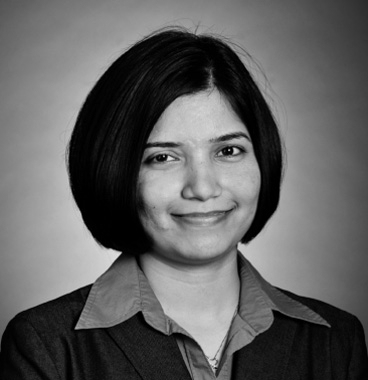System Design and Management (SDM) student Rutu Manchiganti's thesis focuses on how the mental models and biases of companies in the mobile space affect their various product strategies. Does Apple, for example, see all devices through a product-design lens? At Nokia, is everything viewed primarily as a phone? Will every piece of hardware Google develops going forward be driven by search?
Manchiganti has worked in the mobile space since graduating with her Bachelor's in Engineering from India's Gujarat University in 2001. Hired right out of college as a software engineer by Motorola, she moved to the U.S. in 2005 and by 2008 rose to Senior Staff Systems Engineer, working with software development teams focusing on the Symbian platform, one of several supported by Motorola devices. But in early 2009 Motorola decided to put all its eggs in the Android basket and shut down Manchiganti's product line and team, leaving her to ponder her future while trying to decide whether Motorola's decision was foolhardy or bold.
At first, Manchiganti applied to MBA programs, thinking that an MBA would "give me enough knowledge to provide a kick-start in a new direction." As she waited to hear back, she resumed a youthful passion — artistic roller skating — and entered and won a small national competition. ("Winning was a surprise," Manchiganti says, "but I also realized how difficult it was to perform a three-minute routine.") Then, one of the MBA programs to which she applied suggested she take a look at SDM. When she did, Manchiganti found it "too good to be true.
"I got lucky," she says.
"I'm an engineer and at SDM when I talk, people understand," says Manchiganti, "If I had gone for an MBA, I'd have to explain so many things. And at SDM, while I'm learning business and systems thinking — learning how things fit together and seeing the ways that what you do now will affect everything four months down the road — I'm still able to function as an engineer. Hopefully, I'll be in a position after graduation to determine strategy in the mobile space and make (and market) great software and hardware."
SDM has also provided Manchiganti with a new perspective on Motorola's decision to focus exclusively on Android.
"At first," Manchiganti says, "I thought it was risky for Motorola to cut off revenue streams by abandoning so many platforms. When you close down a revenue stream, it makes growth hard. But my SDM professors applaud the decision, saying that focusing on one platform made it easier for Motorola to do one thing well. They say it mitigated risk and aggregated rather than dispersed expertise. And certainly, Android has been hugely successful. It's been marketed to early adopters and tech enthusiasts, as well as to young males, and it has hit those targets extremely well.
"Before I got to SDM," continues Manchiganti, "I was thinking just in terms of devices. Now I'm thinking of the whole ecosystem: applications, ancillary products, marketing, how mobile devices integrate with other products and development strategies. I guess that's my biggest learning at SDM: How to think about all the things that fit together."
Manchiganti has worked in the mobile space since graduating with her Bachelor's in Engineering from India's Gujarat University in 2001. Hired right out of college as a software engineer by Motorola, she moved to the U.S. in 2005 and by 2008 rose to Senior Staff Systems Engineer, working with software development teams focusing on the Symbian platform, one of several supported by Motorola devices. But in early 2009 Motorola decided to put all its eggs in the Android basket and shut down Manchiganti's product line and team, leaving her to ponder her future while trying to decide whether Motorola's decision was foolhardy or bold.
At first, Manchiganti applied to MBA programs, thinking that an MBA would "give me enough knowledge to provide a kick-start in a new direction." As she waited to hear back, she resumed a youthful passion — artistic roller skating — and entered and won a small national competition. ("Winning was a surprise," Manchiganti says, "but I also realized how difficult it was to perform a three-minute routine.") Then, one of the MBA programs to which she applied suggested she take a look at SDM. When she did, Manchiganti found it "too good to be true.
"I got lucky," she says.
"I'm an engineer and at SDM when I talk, people understand," says Manchiganti, "If I had gone for an MBA, I'd have to explain so many things. And at SDM, while I'm learning business and systems thinking — learning how things fit together and seeing the ways that what you do now will affect everything four months down the road — I'm still able to function as an engineer. Hopefully, I'll be in a position after graduation to determine strategy in the mobile space and make (and market) great software and hardware."
SDM has also provided Manchiganti with a new perspective on Motorola's decision to focus exclusively on Android.
"At first," Manchiganti says, "I thought it was risky for Motorola to cut off revenue streams by abandoning so many platforms. When you close down a revenue stream, it makes growth hard. But my SDM professors applaud the decision, saying that focusing on one platform made it easier for Motorola to do one thing well. They say it mitigated risk and aggregated rather than dispersed expertise. And certainly, Android has been hugely successful. It's been marketed to early adopters and tech enthusiasts, as well as to young males, and it has hit those targets extremely well.
"Before I got to SDM," continues Manchiganti, "I was thinking just in terms of devices. Now I'm thinking of the whole ecosystem: applications, ancillary products, marketing, how mobile devices integrate with other products and development strategies. I guess that's my biggest learning at SDM: How to think about all the things that fit together."






